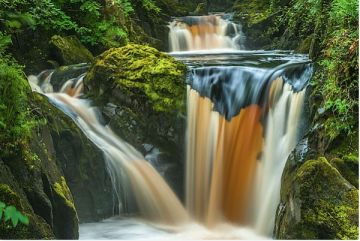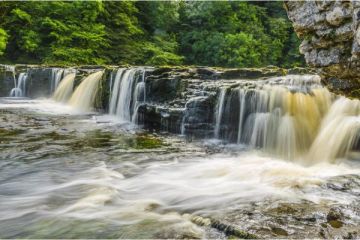by Dean Halsall
North West England is a walker's paradise. The Lake District is the most popular location with picturesque villages, mountains, lakes and superb scenery. South east of the Lakes and the limestone hills of the Yorkshire Dales touch the edge of Lancashire.
Lancashire, and especially its Hill Country, is criss-crossed by thousands of miles of public footpaths.

Lancashire, particularly in the 18th and 19th centuries, was the centre of the cotton mill industry in Britain but a collapse in the Trade links with America brought about the downfall of the industry.
Lancashire was also known for its coal mining industry. If you know where to look you will find local history dating all the way back to the time when England was ruled by the Romans.
Lancashire contains excellent walking possibilities and it has the benefit of not getting as crowded as the Lake District so you don't spend as much time sitting in traffic (but I still love the Lakes too). Walking helps bring the history of the place alive, and many places just can't be seen by car. One of my favourite walks is a 7½ mile route that begins at Roddlesworth Visitors Centre, next to the Royal Arms Pub.

The walk leads through the ruins of an 18th-century manor, Hollinshead Hall, where the waters of a well were reputed to have mysterious healing powers. Hollinshead was the manor house of Tockholes but all that is left today are the ruins of the halls, stables, farm buildings and an early 19th-century farmhouse.
It is not known how old the site is but it is suggested that it was a Celtic homestead. An early history book of Lancashire says that the whole area was covered by Forest providing hunting during the reigns of the Anglo-Norman Kings. It is known that there has been a hall or manor house on the site since the 14th century. When the last building fell into decay it was demolished and the stone used to build a roadside wall (what a pity).
In one corner of the grounds is a well-house, thought to be 17th century, whose water has legendary healing properties for eyes. It is known as the wishing well or holy well and has a long mysterious past. Here five springs of water unite and collect in a larger stone tank at the rear. The building itself is probably 18th century but the lion well head is much older.
The route continues over old mining paths to Darwen Tower, built in 1897 to commemorate Queen Victoria's Diamond Jubilee. It is possible to climb the spiral staircase to the top of the 86ft tower, from here ther are superb views.
From Darwen Hill, the 300ft India Mill chimney can be seen. The textile magnate Eccles Shorrock built the mill in the 1850s. Shorrock was the last owner of Hollinshead Hall, though he never actually lived there.
Further on down the trail is the 86 acre Sunnyhurst Wood with its seven miles of public footpaths. The wood was acquired in 1902 to commemorate the coronation of King Edward VII and has a Visitors Centre, tea shop and kiosk.
From here the path goes back to Tockholes village. In the village is the Victoria Pub, good food and beer. There are also several old churches - the United Reform Chapel and the Church of St. Stephen.
The walk is great because it has something for everyone, it's not too strenuous, there is plenty to see along the way especially the history and the superb views.
ABOUT THE AUTHOR
Dean Halsall runs Northwestwalks, offering guided walks throughout Northwest England including the Lake District, Yorkshire Dales, and Lancashire Hill Country and from his home village Standish, near Wigan. They offer scheduled walks, weekend breaks and customised walks and walking holidays on request. For further information visit www.northwestwalks.co.uk, email nww@northwestwalks.co.uk or telephone 01257 472019.


